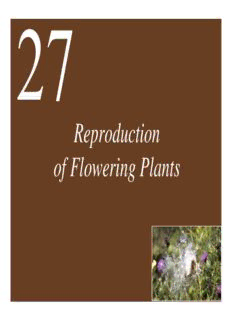
Ch27 Lecture-Reproduction of Flowering Plants PDF
Preview Ch27 Lecture-Reproduction of Flowering Plants
Reproduction of Flowering Plants Chapter 27 Reproduction of Flowering Plants Key Concepts • 27.1 Most Angiosperms Reproduce Sexually • 27.2 Hormones and Signaling Determine the Transition from the Vegetative to the Reproductive State • 27.3 Angiosperms Can Reproduce Asexually Chapter 27 Opening Question How did an understanding of angiosperm reproduction allow floriculturists to develop a commercially successful poinsettia? Concept 27.1 Most Angiosperms Reproduce Sexually Most angiosperms reproduce sexually—this strategy results in the genetic diversity that is the raw material for evolution. Concept 27.1 Most Angiosperms Reproduce Sexually Differences between sexual reproduction in angiosperms and in vertebrate animals: • Meiosis in plants produces spores, after which mitosis produces gametes. • Most plants have alternation of generations. • In plants, cells that will form gametes are determined in the adult organism. Concept 27.1 Most Angiosperms Reproduce Sexually Male and female gametophytes are contained in flowers. A complete flower consists of four concentric groups of organs arising from modified leaves: Concept 27.1 Most Angiosperms Reproduce Sexually • Carpels—female sex organs that contain the developing female gametophytes • Stamens—male sex organs that contain the developing male gametophytes Perfect flowers have both carpels and stamens Imperfect flowers have only male or only female organs Figure 27.1 Perfect and Imperfect Flowers (Part 1) Concept 27.1 Most Angiosperms Reproduce Sexually Imperfect flowers: Monoecious—male and female flowers on the same plant Dioecious—individual plants have only male or only female flowers Figure 27.1 Perfect and Imperfect Flowers (Part 2)
Description: